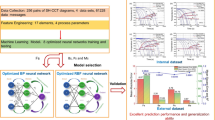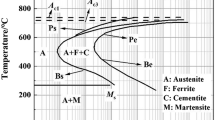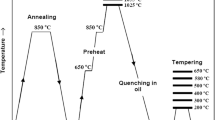Abstract
In the present study, an artificial neural networks-based model was developed to predict the ferrite fraction of microalloyed steels during continuous cooling. Fourteen parameters affecting the ferrite fraction were considered as inputs, including the cooling rate, initial austenite grain size, and different chemical compositions. The network was then trained to predict the ferrite fraction amounts as outputs. A multilayer feed-forward back-propagation network was developed and trained using experimental data form literatures. The predicted values are in very good agreement with the measured ones indicating that the developed model is very accurate and has the great ability for predicting the ferrite fraction.





Similar content being viewed by others
References
Pandi R (1998) Ph.D. Thesis, The University of British Columbia, Vancouver, Canada
Militzer M, Pandi R, Hawbolt EB (1996) Ferrite nucleation and growth during continuous cooling. Metall Mater Trans A 27:1547–1556
Militzer M, Hawbolt EB, Meadowcroft TR (2000) Microstructural model for hot strip rolling of high-strength low-alloy steels. Metall Mater Trans A 31:1247–1259
Militzer M, Hawbolt EB, Meadowcroft TR (1995) Ferrite nucleation during continuous cooling. In: Hawbolt EB, Yue S (eds) Phase transformations during the thermal/mechanical processing of steel. The Metallurgical Society of CIM, Montreal, pp 445–458
Pandi R, Militzer M, Hawbolt EB, Meadowcroft TR (1995) Modelling of austenite decomposition kinetics in steels during run-out table cooling. In: Hawbolt EB, Yue S (eds) Phase transformations during the thermal/mechanical processing of steel. The Metallurgical Society of CIM, Montreal, pp 459–471
Porter DA, Easterling KE (1992) Phase transformations in metals and alloys, 2nd edn. Chapman & Hall, London
Speich GR, Scoonover TM (1988) Continuous-cooling-transformation behavior and strength of HSLA-80 (A710) steel plates. In: DeArdo AJ (ed) Processing, microstructure and properties of HSLA steels. AIME, New York, pp 263–286
Pereloma EV, Boyd JD (1996) Effects of simulated on line accelerated cooling processing on transformation temperatures and microstructure in microalloyed steels part 1—strip processing. Mater Sci Technol 12:808–817
Coldren AP, Cryderman RL, Semchyshen M (1969) Steel strengthening mechanisms, AMAX, p 17
Heedman P, Sjostrom A (1983) M.Jarl, HSLA Steels Technology and Applications, organized by M.Korchinsky, Philadelphia, PA, ASM, 121
Grozier JD (1977) Microalloying’75. Union Carbide Corp, New York, p 241
Petkov P (2004) Austenite decomposition of low carbon high strength steels during continuous cooling. Master’s thesis, The University of British Columbia
Thewils G (1994) Transformation kinetics of ferrous weld metals. Mater Sci Technol 10:110–125
Nakata N, Militzer Microstructural (2000) Mechanical working and steel processing conference proceedings, vol XXXVIII. ISS, Warrendale, PA, p 813
Umemoto M, Komatsubara N, Tamura I (1980) Prediction of hardenability effects from isothermal transformation kinetics. J Heat Treat 1:57–64
Bradley JR, Aaronson HI (1981) Growth kinetics of grain boundary ferrite allotriomorphs in Fe–C–X alloys. Metall Trans A 12:1729–1741
Gilmour JB, Purdy GR, Kirkaldy JS (1972) Partion of manganese during proeutectoid ferrite transformation in steel. Metall Trans A 3:3213–3222
Khalaj G, Yoozbashizadeh H, Khodabandeh A, Nazari A (2011) Artificial neural network to predict the effect of heat treatments on Vickers microhardness of low- carbon Nb microalloyed steels. Neural Comput Appl. doi:10.1007/s00521-011-0779-z
Perlovsky LI (2001) Neural networks and intellect. Oxford University Press, Oxford
Guzelbey IH, Cevik A, Gögüs MT (2006) Prediction of rotation capacity of wide flange beams using neural networks. J Constr Steel Res 62:950–961
Cevik A, Guzelbey IH (2008) Neural network modeling of strength enhancement for Cfrp confined concrete cylinders. Build Environ 43:751–763
Cevik A, Guzelbey IH (2007) A soft computing based approach for the prediction of ultimate strength of metal plates in compression. Eng Struct 29(3):383–394
Guzelbey IH, Cevik A, Erklig A (2006) Prediction of web crippling strength of cold-formed steel sheetings using neural networks. J Constr Steel Res 62:962–973
A. Nazari, A. Sedghi, N. Didehvar (2011) Modeling impact resistance of aluminum-epoxy laminated composites by artificial neural networks. J Compos Mater. doi:10.1177/0021998311421222
Nazari A, Riahi S (2011) Artificial neural networks to prediction total specific pore volume of geopolymers produced from waste ashes. Neural Comput Appl. doi:10.1007/s00521-011-0760-x
Nazari A (2011) Application of artificial neural networks for analytical modeling of Charpy impact energy of functionally graded steels. Neural Comput Appl. doi:10.1007/s00521-011-0761-9
Nazari A (2011) Microhardness profile prediction of functionally graded steels by artificial neural networks. Int J Damage Mech. doi:10.1177/1056789511432653
Nazari A, Riahi S (2011) Prediction split tensile strength and water permeability of high strength concrete containing TiO2 nanoparticles by artificial neural network and genetic programming. Compos Part B Eng 42:473–488
Nazari A (2012) Artificial neural networks to prediction compressive strength of geopolymers with seeded waste ashes. Neural Comput Appl. doi:10.1007/s00521-012-0931-4
Nazari A, Riahi S (2011) Computer-aided design of the effects of Fe2O3 nanoparticles on split tensile strength and water permeability of high strength concrete. Mater Des 32:3966–3979
Col M, Ertunc HM, Yılmaz M (2007) An artificial neural network model for toughness properties in microalloyed steel in consideration of industrial production conditions. Mater Des 28:488–495
Nazari A, Milani AA, Zakeri M (2011) Modeling ductile to brittle transition temperature of functionally graded steels by artificial neural networks. Comput Mater Sci 50:2028–2037
Tafteh R (2011) Austenite decomposition in an X80 linepipe steel. Master’s thesis, The University of British Columbia
Gerami S (2010) Characterization and microstructural evolution model of a Nb complex phase steel. Master’s thesis, The University of British Columbia
Lottey KK (2002) Austenite decomposition of a HSLA-Nb,Ti steel and an A1-TRIP steel during continuous cooling. Master’s thesis, The University of British Columbia
Olasolo M, Uranga P, Rodriguez-Ibabe JM, Lo′pez B (2011) Effect of austenite microstructure and cooling rate on transformation characteristics in a low carbon Nb–V microalloyed steel. Mater Sci Eng, A 528:2559–2569
Xu L, Xing J, Wei S, Zhang Y, Long R (2006) Artificial neural network prediction of retained austenite content and impact toughness of high-vanadium high speed steel (HVHSS). Mater Sci Eng, A 433:251–256
Xu L, Xing J, Wei S, Zhang Y, Long R (2007) Optimization of heat treatment technique of high-vanadium high-speed steel based on back-propagation neural networks. Mater Des 28:1425–1432
Bahrami A, Mousavi Anijdan SH, Ekrami A (2005) Prediction of mechanical properties of DP steels using neural network model. J Alloys Compd 392:177–182
Enomoto M, Aaronson H (1986) Nucleation kinetics of proeutectoid ferrite at austenite grain boundaries in Fe–C–X alloys. Metall Trans A 17 A(8):1385–1397
Enomoto M, Lange WF, Aaronson HI (1986) Kinetics of ferrite nucleation at austenite grain edges in Fe–C and Fe–C–X alloys. Metall Trans A 17 A(8):1399–1407
Umemoto M, Guo ZH, Tamura I (1987) Effect of cooling rate on grain size of ferrite in a carbon steel. Mater Sci Technol 3(4):249–255
Siwecki T, Zajac S (1991) Recrystallization controlled rolling and accelerated cooling of Ti–V–(Nb)–N microalloyed steels. In: 32nd mechanical working and steel processing conference proceedings, October 1990, Cincinnati, OH, USA. Published by Iron & Steel Soc of AIME. Compendex, pp 441–451
Topcu IB, Sarıdemir M (2008) Prediction of compressive strength of concrete containing fly ash using artificial neural network and fuzzy logic. Comput Mater Sci 41(3):305–311
Author information
Authors and Affiliations
Corresponding author
Rights and permissions
About this article
Cite this article
Khalaj, G., Khoeini, M. & Khakian-Qomi, M. ANN-based prediction of ferrite fraction in continuous cooling of microalloyed steels. Neural Comput & Applic 23, 769–777 (2013). https://doi.org/10.1007/s00521-012-0992-4
Received:
Accepted:
Published:
Issue Date:
DOI: https://doi.org/10.1007/s00521-012-0992-4




